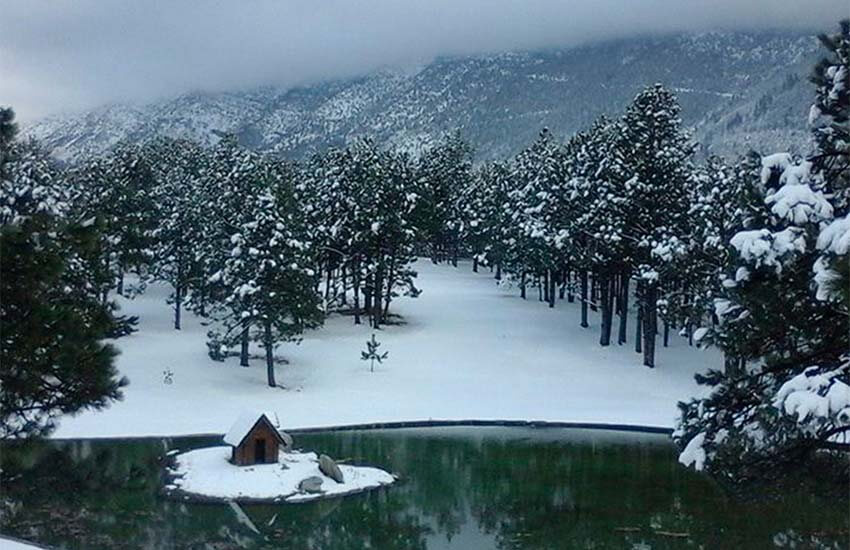When it comes to the concept of “cold,” although Mexico overall cannot hold a candle to places further north, many parts of the country aren’t always a hot tropical paradise either.
Believe it or not, the record for cold in Mexico is -29 C (-20.2 F), recorded in Los Lamentos, Chihuahua in 1962.
Mexico does experience a definite change in weather starting in the fall. Changes in wind patterns cause the end of the rainy season by November, and most of the country notices a drop in temperature.
Depending on your latitude and altitude, you will get anywhere from a break from oppressive heat to weather that necessitates you putting on a sweater or jacket at night. In a few places, you have to bundle up pretty much like up north.
A couple of places in Mexico are tourist attractions for having north-like winter weather. The Bosques de Monterreal ski resort in Coahuila, called the “Switzerland of Mexico” is one. Temperatures here can dip to -10 C.

Just west of Mexico City is the Nevado de Toluca mountain in México state. At 4,680 meters above sea level, winter snow is common at its peak. It’s not the only central Mexican mountain to get snow regularly, but this volcano’s high altitudes are accessible by car. It is not unusual in the city of Toluca to see cars showing off mini-snowmen on the roof or trunk as proof of the trip up.
With the exception of communities at the highest altitudes, uncomfortably cold temperatures are restricted to nighttime and the early morning, with daytime temperatures reaching comfortable levels. The coldest weather is restricted to a few weeks around late January.
Houses generally are not insulated and heated like up north, so there really is no escape from outside temperatures inside the house. If you live in an apartment in Mexico City that does not receive direct sunlight, for example, your place can be quite chilly at all times of day.
It’s a far worse problem for poor communities that live at very high altitudes.
Like further north, much of Mexico’s winter weather is driven by the advances and retreats of Arctic high-pressure systems that come down through Canada and the United States. Mexico generally experiences cold fronts on the southern edge of these systems.
Mexico generally gets about 44 such fronts each winter, but 56 are predicted for this year.

The southern edge means that such fronts are much shorter and milder than what is experienced in the U.S., but they are tracked carefully by weather agencies and news organizations and even distinguished by numbers throughout the season. They cross into the country mostly in the northeast, where their effects are usually strongest, but central and even parts of southern Mexico are affected by air being pushed south.
Cold fronts usually cause cloud cover and a sudden drop in temperature and can cause snow, ice and freezing rain. Precipitation is more likely in areas closer to the Gulf of Mexico.
Such fronts help make Tabasco Mexico’s rainiest state, with an average of over 2,400 millimeters of rain each year, as cold air masses nearly take direct aim at this state in the crook between Veracruz and the Yucatán Peninsula.
The eastern part of the country is the most affected because these frigid air masses make their greatest advances south just east of the Rocky Mountains. Their north-south orientation here has led them and their common effects to be termed nortes (norths). This is a little confusing.
Mexican weather authorities use nortes to refer to a specific weather phenomenon associated with cold fronts that come between October and February. This phenomenon causes high winds and rough seas in the Gulf of Mexico that disrupt important shipping and oil drilling operations.
They are most common in Tamaulipas and Veracruz but can reach as far as Progreso, Yucatán. But for the average Gulf coast resident, the term has come to mean any drop in temperature and any cloudiness (regardless of wind or precipitation) they experience during this time of year.

The instability of weather on most of Mexico’s eastern shoreline is one reason it has been all but ignored by international tourism and foreign residents. It’s not that there is nothing worth seeing on the Gulf coast, but visits here mean keeping an eye on the weather. Of Mexico’s five major resort areas, only one, Cancún, is not on the perpetually sunny Pacific coast, and that is because it is located far enough south to avoid most effects of the nortes.
Despite this, there has been some increase of foreign visitors and residents looking for something different, especially in northern Veracruz. Those not bothered by the changeable weather are rewarded by lush, green rainforests year-round and the ability to avoid throngs of other gringos.
Leigh Thelmadatter arrived in Mexico 18 years ago and fell in love with the land and the culture in particular its handcrafts and art. She is the author of Mexican Cartonería: Paper, Paste and Fiesta (Schiffer 2019). Her culture column appears regularly on Mexico News Daily.
